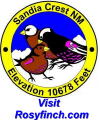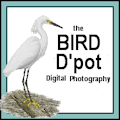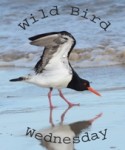Posted by: Ken @ 6:31 am
Our two Illinois granddaughters are visiting, and birding must take a back seat to grandfathering. We finally were able to get out the past three mornings while they are away visiting the theme parks in Orlando. This morning, pouring rain is allowing me some computer face time.
As is our habit, we got out before sunrise. This is the view looking back east, towards the gate where we enter the gravel road that leads into the wetlands.
From the same spot, looking westward towards the Everglades, the ground fog is lifting, but sunlight has not yet reached the tops of the Royal Palms. Sad to think that this placid pathway will some day soon become the busiest parkway in our city. Actually, it will be the only road that traverses our entire city, running 22 miles from the Atlantic Ocean to Okeechobee Highway (US-27), which borders the Everglades preserve.

Welfare checks on the heron rookery have found them doing well, with eggs in five Yellow-crowned Night-Heron nests and one Green Heron nest. A sixth Yellow-crowned nest is difficult to see, but it appears to have been abandoned before any eggs were laid. We suspect there is a second Green Heron nest but is is probably deep in dense vegetation.
The Bald Eagle chick that disappeared from our local nest was probably not flight-ready. During the past three breeding seasons, we observed that the eaglets were usually seen branching or “helicoptering” for eight days prior to taking their first flight. This was never reported for this year’s single chick. Since we found no remains under the nest it probably had been carried off by one of the Raccoons, Bobcats or Gray Foxes that roam in the area. There was even an alligator trail that led to the base of the nest tree from an adjacent canal, also attracted by prey remains. Follow events at the nest and see summaries of observations over the past nesting seasons at the Pembroke Pines Eagle Watch FORUM.
Since we had been walking our birding patch every morning until arrival of our guests, I’ve developed quite a backlog of photos and observations.
At risk of overwhelming readers with heron photos, I must share my first video, taken with a Canon 60D DSLR. Our Texas grandson, after showing me how to set up Skype, then coached me on the features of Windows Live Movie Maker. It is a short clip of a threat display by a male Yellow-crowned Night-Heron.
Here is the link to the video, as some software does not support embedded code:
Palm and Yellow-rumped Warblers have disappeared. We saw our last American Kestrel in late March.
We have not yet seen the hoped-for influx of northbound warblers, tanagers, vireos and orioles. Small flocks of Prairie Warblers have passed through. Some will stay to breed locally.
However, there are signs of spring. The Common Ground-Doves are cooing love songs.
Eastern Towhees are singing on territory. Their whitish eyes identify them as local birds.
In early April it was not unusual to see a half dozen Brown Thrashers along the paths. Most are passing through, but a few will nest locally.
Least Terns have arrived at the lake. Soon the males will be offering little fish to their mates. They probably will nest on the flat roof of a nearby elementary school as well as that of a shopping center.
A Fish Crow unceremoniously displaced them from their perch on the rock, but they returned to dive-bomb the crow and chase him off. My reflexes were too slow to catch the action.
The water levels are dropping in the wetland next to our South Florida subdivision. This concentrates prey and attracts long-legged waders. This week we had our first Black-necked Stilts, a flock of four birds.

A Double-crested Cormorant dries its wings.
The lake margin provides a nesting tree for a pair of Green Herons. Expert contortionists, they assume many different sizes and shapes. During breeding season, the female’s yellow legs distinguish her from the male, which has orange legs.
The female ruffled her feathers as the male flew in, perhaps a recognition signal.
They flew together back to the nest tree, where the male transformed from a compact ball of feathers…
…to a long-necked monster.
As the male took flight he provided me with an image of intricate feather patterns (click on the photo and view it in large size to study the plumage detail).
Before our guests arrived, I visited Plantation Preserve with the Tropical Audubon Society. There we saw this Limpkin.
Rather unusual, at least for me, was to witness the Limpkin’s habit of dunking into the water like a puddle duck.































